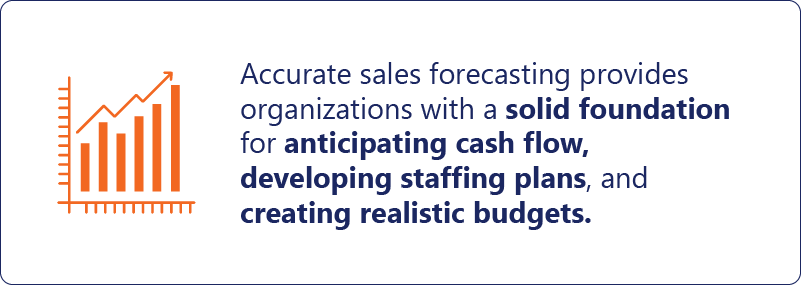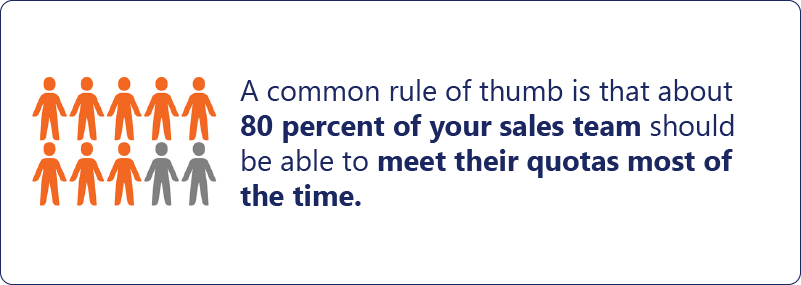7-minute read
Quick summary: Artificial intelligence (AI) and machine learning (ML) help businesses take some of the guesswork out of their sales forecasting and sales quota setting.
Accurate sales forecasting provides organizations with a solid foundation for anticipating cash flow, developing staffing plans, and creating realistic budgets. When we drill down to the level of individual sales reps, accurate sales quota setting enables fair compensation—a key asset in retaining top sales personnel and attracting new talent to the team.
Traditionally, organizations have relied on a combination of historical data and growth objectives—usually supplemented by “gut feel” estimates—to set objectives on the organizational, sales team, and individual rep levels. But as any stockbroker will attest, past performance is not indicative of future results … or at least not always.
If the past couple of years have taught us anything, it’s that things can appear out of the blue at any time to make the best-laid forecasts obsolete and quotas hard to work. These disruptors can be planned (e.g. a merger or acquisition) or unplanned (e.g. staff turnover, new competitors, recessions, … and of course, pandemics). So, given the fragile nature of forecasts based on historic data, what’s a sales organization to do? Machine learning may not be the answer, but it can definitely help organizations become more agile in navigating an ever-changing environment.

Sales forecasting versus sales quota setting
On the surface, sales forecasting and quota setting may appear to be two ends of the same process: one top-down and the other bottom-up. Forecasts trickle down into quotas, and quotas bubble up into forecasts, right?
The (somewhat) smooth seas of sales forecasting
Sales forecasting takes into account a broad range of internal and external factors, such as past performance, size of the sales team, global and local economic predictions, industry trends, and the competitive landscape. In contrast to quotas, forecasts can—and generally do—change constantly based on shifts in one or more of these factors.
From the moment forecasts are set, leadership continues to monitor and predict performance. Accurate and continuous forecasting delivers a competitive advantage, enabling businesses to be agile in managing sales performance and developing incentives to influence the achievement of their goals.



The (somewhat) controlled chaos of sales quota setting
German statesman Otto von Bismarck once quipped, “Laws are like sausages; it is better not to see them being made.” Today he could very well be talking about setting sales quotas. Yes, quotas are impacted by sales forecasts, but that’s just the tip of a massive iceberg—i.e., the series of negotiations that take place among sales reps, managers, area leads, and solution leads, just to name a few. Each stakeholder has their own perspective on where quotas should be set (and why), and after a seemingly endless maelstrom of back-and-forthing, concrete numbers eventually emerge.
With sales quotas, the goal tends to be not “get it right,” but “avoid getting it too horribly wrong.” A common rule of thumb is that about 80 percent of your sales team should be able to meet their quotas most of the time. If you’re seeing less than that, your quotas may be too high, which can negatively impact morale and retention. If more, quotas may be too easy to hit, which may indicate your team is achieving below their potential. As a payroll provider executive once shared in Inc. magazine, “Since you can never win setting quotas, your first goal should be to try to minimize your downside and set rules that drive the behavior of your sales reps to align with your larger goals.”
Unlike sales forecasts, quotas don’t typically change during the period for which they’re set, even if significant disruptions arise. What organizations can do in these situations is build in new sales incentives or even tweak their commission structures to help their reps stay on track. For example, the healthcare industry took a huge hit with the onset of the Covid-19 pandemic. A sales rep focused on that sector would not have seen a change in her quota, but might have been offered adjustments to her patches or incentives to support changing business goals.
How AI and ML support sales forecasting
Answering the big questions
Successful sales forecasting requires answers to four vital questions, each of which can be supported by the intelligent data analysis available via AI and ML:
1. What? What are we planning to sell this year? Or, more accurately, on which solutions should our forecasts be based? For example, should we give greater weight to the problems our prospects have posed or to the solutions we offer?
2. Why? Why are our target customers considering our competitors? What is the gap in our solution offering that drives them to start looking at the competition?
3. How? How do potential buyers make purchases? What are the driving factors? Is their current process different from what they’ve done in the past? How are they evaluating the market to arrive at their decision?
4. Where? Where are buying decisions made, and where do purchasing behaviors occur? Where do we need to focus our marketing efforts?
Addressing key challenges in forecasting
Compared to traditional, manually driven efforts, AI and ML are uniquely well-suited to addressing several key challenges organizations face in sales forecasting:
Scalability: Most manual forecasting processes are based on the volume of data that the human brain can process. With AI and ML, however, businesses can upscale their decision making by incorporating terabytes worth of additional data. If, for example, a traditional forecasting process looks back at the last year or two, an AI- and ML-driven process can easily analyze data going back 10 years or more.
Seasonality: Customers are more or less likely to purchase depending on the time of year, and not all seasonal tendencies are discoverable via manual processes. AI and ML technologies can correlate the time of year of a purchase with customer location, industry, and other factors to more accurately predict when certain customers are more likely to buy.
Competitive market fluidity: Competitive ecosystems are in a constant state of flux, and these changes can have a dramatic effect on sales forecasting. With AI and ML, organizations can tailor their decision making based on predicted outcomes of, for example, a competitor changing its prices or another going out of business.
Trend analysis: AI and ML platforms can identify trends in forecast models that may not be discoverable using manual methods. Forecasting, in contrast to quota setting, is purely data-driven, based on a host of distinguishing factors including the age of the business, size of the sales team, data tracking habits, and quality of data—just to name a few. AI and ML technologies are uniquely capable of accommodating all these factors (and more) to identify trends that can guide more targeted decision making.
Trackability: As the year progresses, AI and ML platforms can track the sales pipeline to analyze how deals are progressing. If unforeseen dips in performance occur, AI and ML provide the business with the means of accurately identifying the underlying cause(s).
Best practices for using AI and ML in sales forecasting and quota setting
Sales forecasting requires following best practices in analyzing time series data, which include the following:
• Ensure a constantly refinable cycle of steps. Your model should be able to constantly reformat and optimize itself as it produces new forecasts with new parameters.
• Make sure your data is up to the challenge. Your data should clean, current, and reliable, and all teams should be practicing good data hygiene continuously. Also verify that there are no significant gaps that could throw off your results.
• Train your validation models. Use k-fold cross validation to ensure you can leverage your data set to construct a generalized model.
• Enable continuous learning and testing. Make sure your model is set up to learn continuously from inputs and outcomes, enabling results to become more accurate over time, and test the validity of results on a regular basis.
Take your sales predictions to a whole new level
Applying artificial intelligence and machine learning transforms your sales predictions and quota setting into data-driven processes. By analyzing huge amounts of data from multiple sources and applying human-like decision making capabilities, these advanced methods can drive increasingly accurate forecasts and fair quotas. The results: a happier sales team, higher confidence levels in planning and budget setting, and greater agility in responding to whatever the future holds. Sounds like a win-win to me.
Further reading: Find out how we helped a tech giant use machine learning to increase revenues.
Like what you see?

Nick Maddock, Managing Director of Strategy & Operations at Logic20/20, is responsible for consulting innovation and the close partnership between consulting and sales.

